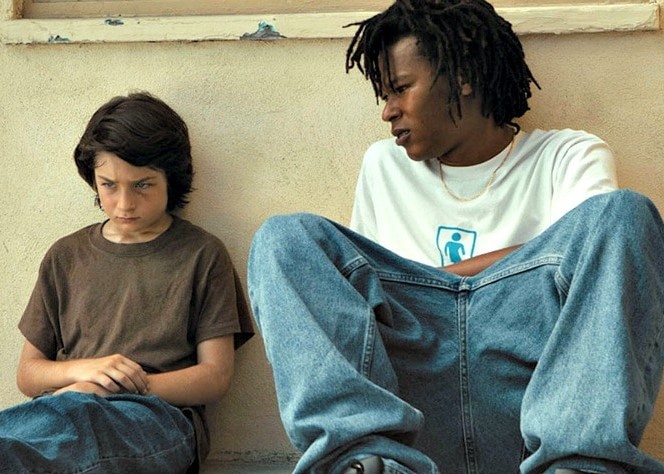Heaven is a halfpipe for Hill.
Jonah Hill makes his directorial debut with Mid90s, continuing to diversify his career and joining a long list of actor-turned-directors. He’s certainly got a sense of style, with a woozy, washed out colour palette which gives the impression you’re watching a video from the 90s.
The drama centers around a young boy named Stevie (played by Sunny Suljic) who falls in with a group of older, skateboarding kids. With them he finds an escape from his ill-tempered brother and his young mother, but with the new sense of freedom, he’s also exposed to more choices and struggles.
Everything in this film hinges around the friendship between this group of teenage boys, out on the streets of Los Angeles, skating in the summer. Na-Kel Smith (an actual skateboarding star) plays Ray and is joined by Olan Prenatt as Fuckshit, Gio Galicia as Ruben and Ryder McLaughlin as Fourth Grade. Stevie gets the nickname Sunburn and it’s this kind of inane stuff concerning nicknames and where they’re earned that puts you on the inside track with the group, as with any group of friends.
Which leads nicely onto the next thing about this film, the drama hints at what is rightly being labelled as toxic masculinity these days, and how all that plays out for young boys looking for an identity. Whether Jonah Hill has meant it or not, this film runs as a soft commentary about how fragile your friendships can be and how they shape the values you pick up, and thus, the person you become.
‘Real life isn’t a well-rounded story and not everything has to be a lesson.’
Ray and Fuckshit are best friends but offer two sides of the coin; Ray wants to go pro and make something of his life, while Fuckshit wants to party, get drunk and chase girls. These two options constantly swirl around Stevie as he works hard to learn how to skate, but he ends up drinking, smoking and fighting with his older brother, too. For Stevie, all he wants are friends and a sense of belonging – something others might be willing to exploit in future
These hazy, formative years are only just beginning for Stevie and he sees a lot. While Ray shows moments of guidance for him, you can’t help shake the feeling things aren’t going to go well for Stevie even after the film has ended. The shots throughout offer both calm and chaos in equal measure – from a mass exodus of a park as police chase packs of teens running every which way, to the holding shot down the middle of a busy street, the gang skateboarding downhill towards camera at dusk.
With a film title as definite as “mid90s” there was a risk this could become a kitsch look at the decade in which I was a kid, but the pop-culture is kept low-key, with only Teenage Mutant Ninja Turtle bed covers and old consoles being the giveaways. Of course, the 90s also saw a rise in skateboarding (mine had Power Rangers on it and I couldn’t skate at all), which is the hook the film pivots on for movement visually.
Another detail I enjoyed was the fact that you can tell where a kid is at because of what they put up on their walls. Your bedroom walls are your canvas and you can paint them with a style through posters and clippings, something Stevie does as he decides skateboarding is the way forward for him. It’s not glossy and overdone, it’s a mood board.
What I think people will most dislike about this film, if they choose anything to dislike, is the lack of any real outcome. In the end, little has been settled and it’s unclear whether lessons will have been learned. Of course, that’s also the beauty of Jonah Hill’s film: it’s honest. Real life isn’t a well-rounded story and not everything has to be a lesson.
